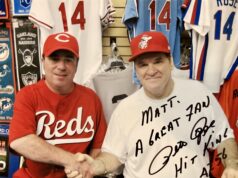By Heather C. Watson
Once upon a time, the University of Kentucky’s premiere athletic teams were coached by two talented and ambitious men. As is the case with many smart, ambitious and talented men, the two clashed from time to time. And, the story goes, their professional tenures became increasingly marked by petty jealousies involving Cadillacs and cigarette lighters, with the ultimate result being the defection of a potentially great football coach. This tale has been relayed to generations of young Kentuckians with a reverence equal to that reserved for stories of Governor Goebel’s shooting or President Lincoln’s humble beginnings in a Hodgenville log cabin. As any good Wildcat fan can tell you, the coaches were Adolph Rupp and Bear Bryant, long before they were immortalized for their respective Brown Suit and Houndstooth Hat. Whether the gossip of decades past is entirely accurate may be an issue lost to the ages. However, the moral of this story rings loud and clear to even the youngest Wildcat fan: We made the decision in the 1950s that we would be a basketball school. A football legacy wasn’t on the University of Kentucky’s agenda.
More than 50 years after those wheels were set into motion, I sat in Commonwealth Stadium’s end zone, taking in the 2009 Kentucky-Tennessee game. After losing twenty-four consecutive games in the series, it seemed that we had those damned elusive Vols in our grasp. We weren’t discussing whether we’d be headed to a Bowl game at season’s end, but rather where our post-season play would occur. AUK fan’s proud sign summed up our confidence and our ebullient hope: “In Paw Paw We Trust.†In the bitterly cold November night, I began to cry; I wasn’t sure whether the tears were a product of the harsh elements, the emotionally charged game, or the amazing resurgence of Kentucky football. I did know, however, that we had Paw Paw to thank for all our successes. As I looked around the stadium, I realized how very far our football program had risen in seven short years: We expected to win games. We took Bowl appearances for granted. Our coach wasn’t maligned or embattled; in fact, we’d given him a loving nickname. Football tickets were no longer an aspirational item purchased in lieu of elusive and pricey basketball tickets, nor were football games an excuse to drink beer in the interstitial periods between racing and basketball. In fact, we now left the tailgates well in advance of kickoff — we suddenly wanted to watch the game. Under the guidance of Rich Brooks, we began to perceive our football program with pride: Kentucky football under Paw Paw was successful, cleanly-run, and fun to watch.
Rich Brooks’ arrival at Kentucky holds few of the hallmarks of a legendary tenure. After the debacle of the Mumme-Morriss era, we were looking for someone clean and reliable. Wins were far less crucial than the lack of additional sanctions. Coach Brooks quietly fulfilled the humble job requirements of honesty and freedom from scandal, but ultimately did far more: he turned our program around.
The first three seasons of the Brooks era were far from spectacular; they can most kindly be characterized as rebuilding years. Soon, however, Coach Brooks’ teams were distinguishing themselves with winning records and Bowl appearances. Kentucky’s high-profile players suddenly became NFL prospects. And the fans could rest assured that the kindfaced, gentle man leading our team was abiding by NCAA rules. The fans’ confident signs were carefully phrased and deeply felt: In Paw Paw, we knew, we could trust.
The legacy of the Paw Paw era is a clean program, winning seasons, and restored pride in Kentucky football. It seems only fitting that his post-season record (3-1 in Bowl games) ties that of the Bear. In many ways, Coach Brooks picked up where he left off.
Floyd County native Heather Watson holds degrees from Transylvania University and the University of Kentucky. She lives in Lexington with her fiancé, Bob, and their Black Lab, Max. Follow her at http://www.twitter.com/heathercw







